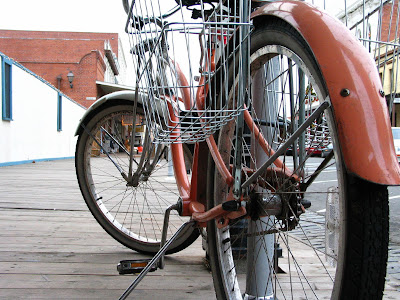
From Yahoo News, 07.31.09:
House approves $2B more for 'cash for clunkers'The absolute insanity of this is just staggering.
The House has voted to rush an additional $2 billion into the popular but financially strapped "cash for clunkers" car purchase program.
The bill was approved on a vote of 316-109. House members acted within hours of learning from Transportation Secretary Ray LaHood that the program was running out of money.
Called the Car Allowance Rebate System, or CARS, the program is designed to help the economy and the environment by spurring new car sales. Car owners can receive federal subsidies of up to $4,500 for trading in their old cars for new ones that achieve significantly higher gas mileage. (Read more.)
Transit is starving, Amtrak is wheezing, bicyclists and pedestrians lack adequate facilities, yet the government happily tosses billions and billions of (borrowed) dollars at motorists. It's like a giant national Oprah show: "Everyone gets a new car!"
Easy credit for the masses has vanished. Catastrophic global climate change looms. Oil is running out. (We can debate whether we're at peak, beyond peak or nearing peak, but we don't call petroleum a "non-renewable resource" for nothing.) Simply put, the "happy motoring" era is finished, period. We need to get smarter about our transportation investments, if we are going to continue to have any kind of sustainable economy. This stupid revanchist "cash for clunkers" scheme does nothing to wean Americans off petro-dependency and debt overload. And don't get me started on the social justice inequity of all this (low-income transit riders facing cuts and fare hikes, while middle-class suburbanites buy new Ford Escape Hybrid SUVs.)
Worst of all, it appears the environmental advocacy community completely laid down for this. I even got a message from the Sierra Club: "Put Cash for Clunkers to Good Use."
Where's the environmental benefit? The 1,000 gallons or so of energy "embedded" in the prior manufacture of the existing clunker will be scrapped, so the new more fuel efficient consumer can save maybe 50 gallons a year? Huh?
Sustainable transportation advocates have long been frustrated by the failure of mainstream environmental organizations, obsessed with fantasies about clean energy or efficient vehicles. Transit has been on the chopping block everywhere, with negligible opposition from environmentalists.
If Congress wants to save jobs with some subsidy to the auto industry, we should demand concessions. Say a $1-a-gallon surcharge on gas dedicated to transit, walking, and bicycling in exchange for this freebie to motorists.
Bicycle advocates active with Sierra Club, National Resources Defense Council, League of Conservation Voters, and other enviro groups need to demand greater efforts for sustainable, not efficient transportation. Our economic future will be determined by how quickly we shift from a transportation system based on driving alone to one based on bicycling, walking, passenger rail, and public transit.
Image: Web capture.
Visit: Cash-for-Clunkers: An ‘Expensive’ Way to Reduce Emissions, Wall Street Journal
Visit: When It Comes to Being Green, Cash for Clunkers Is a Lemon, Washington Post
Visit: Separating Myth From Fact on "Cash for Clunkers", Streetsblog
Visit: "Cash for Clunkers" Program Yields Dubious Benefit, Public Citizen
Visit: Your tax dollars at work to sell more cars, Baltimore Spokes
Visit: CARS Program is actually a C.R.A.P. Program, Get Energy Smart Now
Visit: Sustaining the Unsustainable, WorldChanging.org
Visit: Warning: Oil Supplies Are Running Out Fast, CommonDreams.org
Visit: Paul Dorn's Bike Commuting Tips Site

















